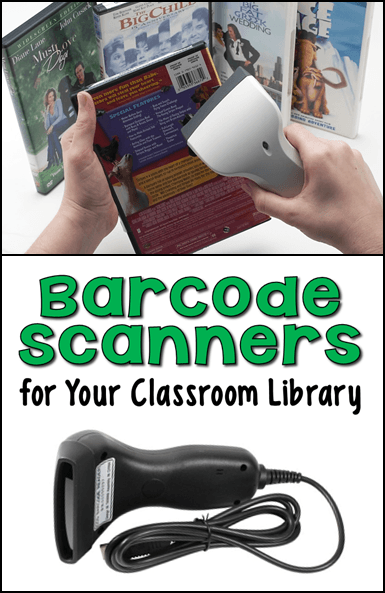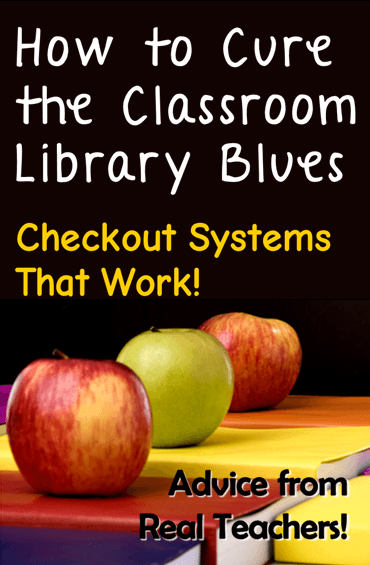Advice from Real Teachers Series
Are you feeling the classroom library blues? Whether you have a huge book collection or you’re just getting started, the cure is finding a checkout system that works for you. Otherwise, you’ll find your book collection dwindling throughout the year. Wouldn’t you love to know how other teachers handle classroom library checkout? Read on to learn some tech-savvy methods as well as some tried-and-true ways to manage a classroom library.
Today’s Question
Ally, a fan of the Teaching Resources Facebook page, asked for help with this issue, “I still struggle with my classroom library procedures. Doesn’t anyone have a process that has worked well and doesn’t result in lost time and lost books?”
Over 100 teachers responded, so I compiled the best answers and removed duplicates. I organized all of the checkout systems into two categories: technology systems and traditional systems. There’s also a third category from teachers who explained why they don’t have ANY checkout system. If you would like to read all of the ideas, you’ll find Ally’s question here on the Teaching Resources Facebook page.

This category includes recommendations for apps that can be used with a mobile device, as well as hand-held barcode scanners. Several people recommended the Intelliscanner which is a bit pricy, but Elizabeth Odrap said she bought similar scanner that was quite a bit cheaper. I’ve included links to those two devices so you can read the reviews on Amazon to see what you think. In the image on the right, the Intelliscanner is shown at the top, and the cheaper, generic scanner is shown at the bottom. Neither of them are wireless, and they both have to be connected to a computer to use them.
- Patti Lyn – I use Intelliscanner. It’s a library scanner with a computer program to log and check out books. It takes some time to scan them in, but it’s well worth it. I have over 1000 books in my classroom library and haven’t lost one yet since I started using it.
- Paula Cull – OMG, I have the Intelliscanner and I LOOOOOOVE IT! I have a huge classroom library and instead of putting all the books in at first, put them in as the students check them out. It’s so easy and you can print reports of who is overdue and who lost books, etc… Best purchase I have made for my classroom!
- Marcie Stowell – I use Booksource Classroom Organizer. It takes a bit of setup time to get all the books entered but once I show it to the kids it runs itself. They can use the computer or iPhone/iPad app to check books out and there is no limit on the number they can check out. I do get a report every 2 weeks and I can see who has what book and for how long but generally when we check in during reading conference I get all that information too. I have over 1000 books (3rd year teacher in 5th grade) and my kids know that I LOVE books. If they fall in love with one I generally gift it to them (or purchase them a new one for themselves) all they have to do is ask. They are completely in charge of the library, it helps teach them accountability and organization
- Elizabeth Odrap – I bought a similar scanner for about $20.00. I use Booksource Classroom Organizer and the scanner attached to a tiny netbook computer for my students to scan and check out their books. I have also used an old iPhone to do it as well, but they love using the scanner! It was an excellent purchase! Easy to install and super each for my third graders to use. I have used this scanner with Classroom Organizer for a year and a half….works great!
- Daina Roberts – I let my kiddos “check out” books to take home… They simply hold their book up and I snap their picture with my phone… they bring it back, I delete the photo…I can easily check daily/weekly/monthly to see who never returned their book because their photo with that book will still be on my phone. Quick and easy and you can even have it be a kid’s job! Could easily do the same thing with a class camera!
- Shelley Rolston – There are apps to help. Check these out: https://en.softonic.com/top/apps-for-keeping-track-of-books
- Staci Arnold – If you have a smartphone, a way you can check books in and out and make sure you know who has returned books and who hasn’t is an app called Book Retriever. I LOVE IT!!!!
Traditional Systems
If you don’t have access to the technology needed for the options above, one these tried-and-true methods might work for you.
- Elizabeth Hailey – Each of my kids has a numbered shelf marker (bookmark) that they put where they pulled out the book. It stays there until they put the book back to get a new one. Since their marker is there personal number, I always know who has what.
- John Blake – One of my classroom community jobs is Librarian. At certain times in the day, this student will open the check-in/out book and write down the students’ books in a binder. Each child has a page in the binder, so it’s easy to see who has books still checked out. My rule is that my students can check a book out as long as they want, but they can only have one out at a time. This is just for books that the children are allowed to bring home. All other books that they read during the day are kept in their book boxes (cardboard magazine files). The only limit is the number of books they can fit in their book boxes. The boxes are kept in a central area in class where they can easily be grabbed for independent reading.
- Susan Ross – My son’s kindergarten teacher had an awesome system. She had the old library pockets and cards in all of her books. The kids each had a library card pocket on their cubby. When they borrow a book, they take the card out of the pocket in the book and put it in the pocket on their cubby. As long as they have a card in their pocket, they know they have a book out and can’t get another. When they return the book, they take the card out of their pocket, and put it back in the book, and put the book back on the shelf/basket. They can exchange books as often as they want. If they don’t want v to borrow a book, they don’t have to. I’d love to do this with my books! It would be a very time consuming project.
- Brittany Barlow – I teach first grade. My books are organized by level. Each hook basket has a label on the outside and each book is labeled with a sticker to the corresponding level. Students have 7-10 books in their book baskets. Each student is assigned a day to “book shop” in which they return their old books to the proper baskets and then get new ones. It was a great system that worked well with firsties after training.
- Shelly Worrall – I have a library pocket and index card in each of my 3,000+ books. Each index card has the book title on it. When a child decides on a book, they hand me the card. I have a 3 prong folder with pages inside. Each page has numbered library pockets attached (4 per page). I place the card into their pocket. When they want a new book, they get their card from me. It just takes a second and I always know where my books are. Comes in handy when students are looking for a specific book.
- Trinity Tracy – I have kids write down the title on a clipboard as they take it out. My name and room number are in each book. When they book is returned, the name is crossed out. If someone finds a book, it usually gets back to me because my information’s in it. Otherwise, it’s basically an honor system because I don’t have time to look for lost books. The names are recorded and if a book’s popular enough a student will hunt down the last one to have it.
- Patty Baumeister – All of the books in my classroom library have my name written inside the front cover. I also write a number inside each book. At the beginning of each year, I give each student a large index card. The students write their name on the card. That is their “library card”. If a student wants to borrow a book, they write the title of the book and the number on the card on the card. They give the card to me. When they return the book, I check that the number on the book matches the number on the card. If they match, the student gets the card back and can borrow another book. I started numbering the books, because I have multiple copies of many books. I know the student actually returned the book they borrowed by checking the numbers. I probably lose 3-5 books a year, but getting students reading at home is more important.
- Eric Meisner – Place in genres. Number basket with the same number on the books. I ask students to write title and their name with current date. They put card in a separate basket. When they return the book they match number with the right basket. They are to remove their card. THIS Works With 4th graders.
- Kristin Slosser – One option is to have two types of books. Have an honor system open section that kids can access easily and on their own with books you got cheap or have multiple copies of. Books that are super popular or special/more expensive/ really new copies that you are more concerned about losing can be on a special access shelf that has to be signed out by you or only read at school or actual due dates or whatever.
Honor Systems – Don’t Worry; Be Happy!
What if ALL of these options seem like wayyyyy too much work? Several teachers had a more relaxed view about their classrooms libraries and didn’t have any formal checkout system at all.
- Kristen Little – My 5th graders take what they want. Some of my kids have several at a time. I want them to learn to love books, share them, stack them, and hoard them! I don’t want to limit reading by being a monitor. Monitoring wastes time in my opinion; if I lose a few so be it. I do have two students that are librarians to keep things in order and re-shelve.
- Laura Grover – Kids are kids, Books get lost or forgotten. My rule is that you are welcome to borrow a book for classroom use only. You may not take them home. It is on the honor system. Sometimes my books show up around the school but they are so well marked with my name that I get them back. If a book disappears, I can only hope it is being well loved somewhere. Too much time, and stress over replaceable items.
Do you have your own library checkout system that works for you? If so, please share it in a comment. If not, which methods in this post interest you?
If you would like to submit a teacher question of your own, be sure to watch for the Question Connection announcement every Wednesday on the Teaching Resources Facebook page. Even if you don’t have a question, please follow me on Facebook and offer your advice when you see the questions come through! Working together, we can accomplish more!







